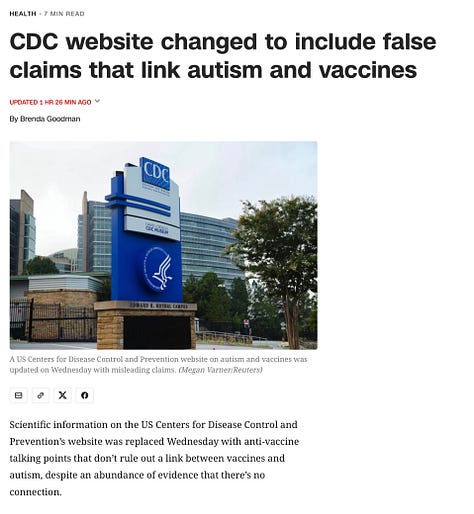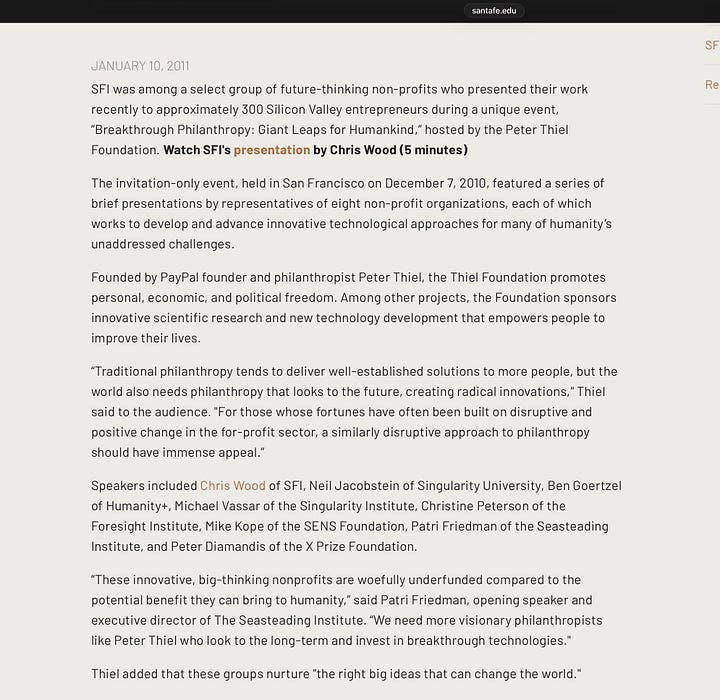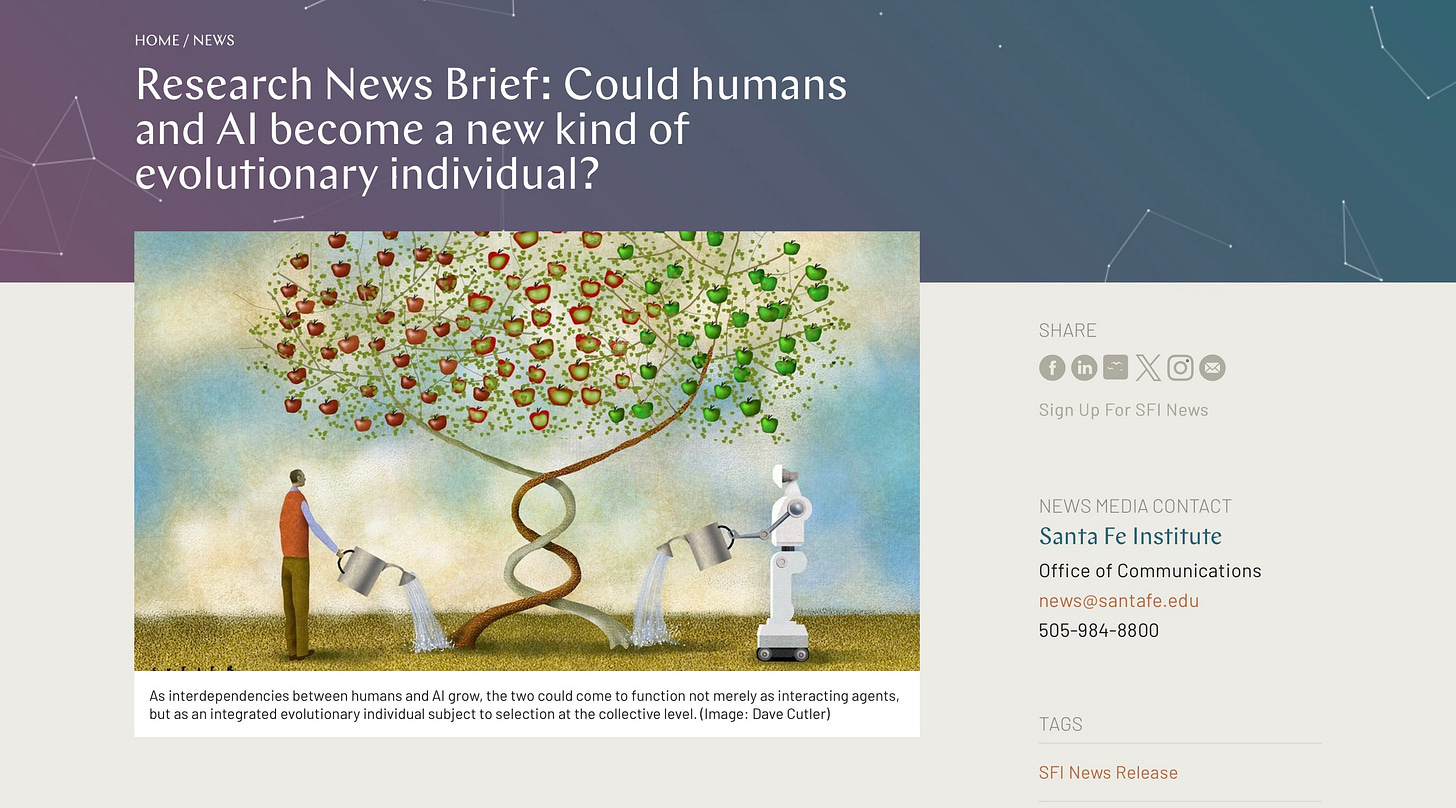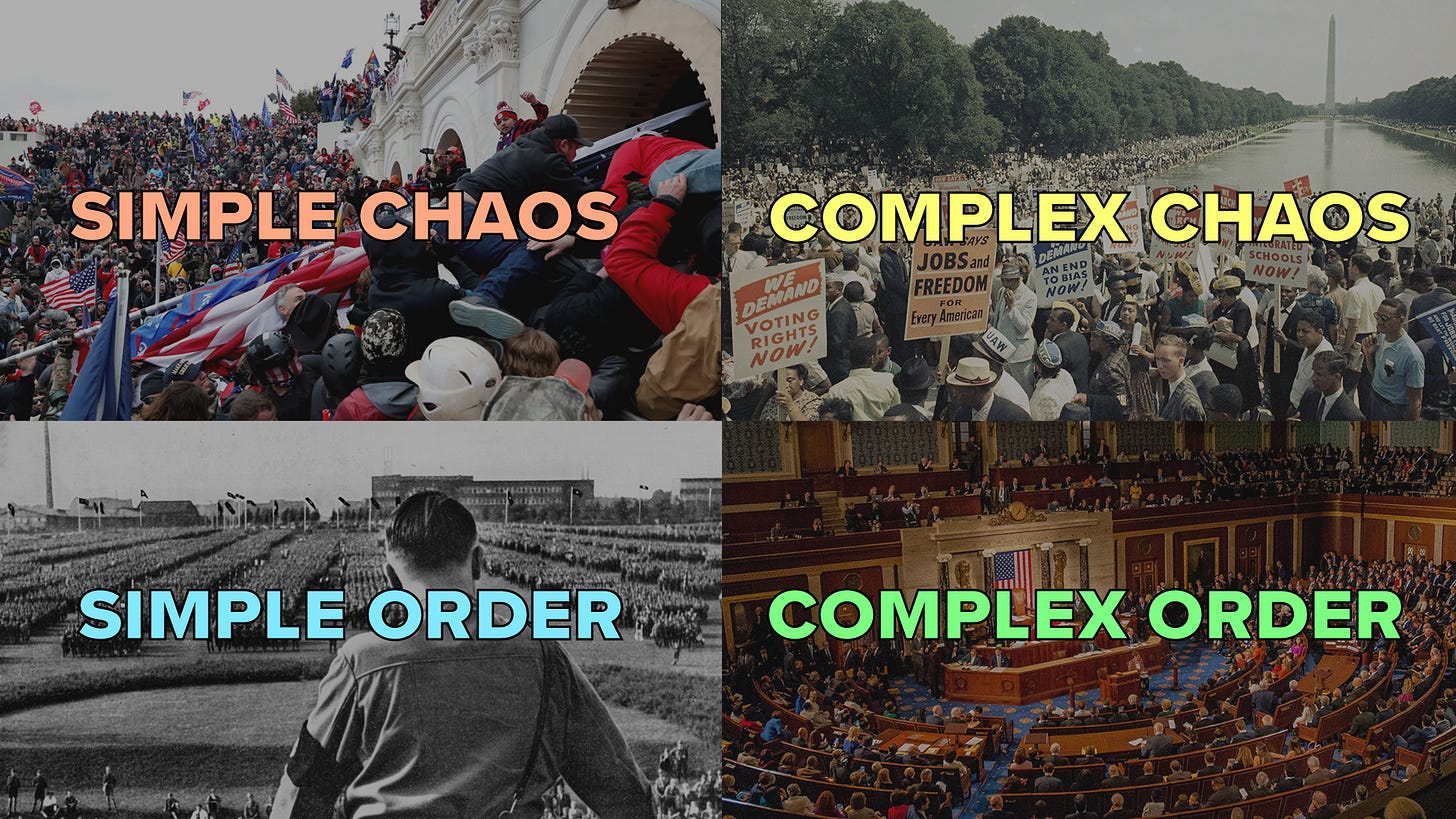Dissolving America: Peter Thiel, Chaos, and the “Hard Reset”
What Democrats need to learn from complexity science.
What appears to be random Trump-regime chaos and cruelty is actually a deliberate strategy of dissolution. Understanding this process clearly and providing the right kind of countermeasures is crucial to the survival of our basic humanity.
The nexus of this strategy is anchored in the unlikely triangle of Peter Thiel, Jeffrey Epstein, and the Santa Fe Institute for complexity science.
Dissolution
As a few examples of the strategy in operation, just last week:
When Democratic lawmakers reminded military service members and the intelligence community that their oaths are to the Constitution and that they should refuse illegal orders, they were accused of “SEDITIOUS BEHAVIOR” by Donald Trump and threatened with execution.
The Center for Disease Control, led by Thiel-crony Jim O‘Neill, replaced science with deadly disinformation on its website, deliberately discouraging people from giving their children vaccines.
The Coast Guard removed the swastika and the noose from its list of hate symbols—and hastily put them back.



And on Friday, the Secretary of Education said eliminating her department would “reverse our national decline with a hard reset.”
“My purpose here is to speak directly to the American families… about the work this administration is doing in education, to reverse our national decline with a hard reset of our educational system. That reset was the top campaign promise from President Trump to send education back to the states and in Washington’s micromanagement of education once and for all.“
Chaos
What do these actions have in common? Chaos. But what does that really mean?
Creating chaos is the same as dissolving order—literally un-solving solutions. This is just as true in politics as it is in chemistry: taking a well-ordered salt crystal and putting it in water is the same dynamic process as taking a well-ordered society and bathing it in hate and ignorance. Both lead to chaos—to dissolving of the system.
Let’s say you have a sculpture made of ice and you want to make a different ice sculpture out of it. How do you do it? You melt it down and refreeze it. You have to break down the existing order before you can create a new one.
Why would someone want to dissolve a complex, pluralistic country? Why would someone want to dissolve order? To provide a different solution.
Melt the State
In 2012, at a libertarian student organization, Peter Thiel laid out the playbook.
“As a society we may have to still go through one last really crazy bubble but when this one is over it will be time to sort of reassess the entire history of the last 200 years and I think the only thing left standing will be something like a libertarian account of what’s going to happen. When the government bubble breaks the people in this room will be the people who will be the only people who have been right all along.
You know, the residual part of it is, of course, the education bubble, which is a very important, subcomponent of the government bubble… you have to keep in the back of your mind the idea that there’s something deeply flawed with it.”
Make no mistake, he meant it literally. Peter Thiel believes that the Enlightenment is a failed project. When he said to “Students for Liberty” that after the “government bubble” bursts “it will be time to sort of reassess the entire history of the last 200 years,” he meant to question not just democracy, but liberalism, pluralism, and equality as worthy principles upon which to build a civilization.
As Stephen Diehl wrote about Thiel:
At the core of Thiel’s ideology a Manichean vision, where the world is a literal battleground between order and chaos, good and evil, with humanity teetering on the brink of self-destruction due to the insidious force of mimetic desire, secular stagnation, and authoritarianism. Thiel perceives himself as an active agent, a harbinger of the future tasked with guiding civilization away from the abyss and towards a more meaningful existence. This sense of urgency fuels his attempts to build a mental model to understand and ultimately shape the course of history.
In this worldview, collapse isn’t a risk, it’s a tool.
Why does it matter that Peter Thiel is adjacent to complexity science in this context? Why does this ideology need chaos?
The key is the difference between chaos and complexity. A complex system can either consume chaos or be destroyed by it. Thiel’s goal is, of course, the latter.
Santa Fe Institute
The Santa Fe Institute (SFI) is a research center for complex systems science founded in 1984 by a number of scientists, including Murray Gell-Mann, a Nobel Prize-winning particle physicist and a longtime associate of Jeffrey Epstein—who funded Gell-Mann’s work for decades.
SFI itself received $275,000 from Epstein.
SFI’s mission is: “Searching for Order in the Complexity of Evolving Worlds.”
Our researchers endeavor to understand and unify the underlying, shared patterns in complex physical, biological, social, cultural, technological, and even possible astrobiological worlds.
SFI has made substantial contributions to complexity science, including foundational components of chaos theory. One of the applications it heavily explores is artificial intelligence and whether AI might overtake humanity.
In November 2010, Jeffrey Epstein hosted the “MindShift Conference” which included Gell-Mann. A month later Peter Thiel hosted Chris Wood from SFI at his annual Thiel Foundation conference.


Jeffrey Epstein and Peter Thiel’s relationship is more extensive than previously acknowledged, including recent disclosures of emails, meetings between the two through 2017, and at least $40 million in investments by Epstein into Thiel’s venture funds.
Peter Thiel sees complexity as another form of chaos, which stems from his own deep pathology and narcissism. He thinks complex order is inefficient and degenerate—and seeks a simpler world as the only solution.
Complexity vs. Chaos: Why It Really Matters
A pluralistic democracy is a system in a state of complex order, which means it is both highly structured and constrained. If you want to replace complex order with something simpler, you can’t just go straight there; you have to add chaos. If you want to make a block out of an ice sculpture, you have to melt it first; you have to dissolve it.
The chart below depicts four dynamic modes of reality expressed in the political domain.
Simple Chaos: Violence, despair, poverty; January 6th, the Great Depression
Complex Chaos: Protest, debate, “good trouble”
Simple Order: Authoritarianism, dictatorship; Hitler, Stalin
Complex Order: A system of checks and balances in a constitutional republic; the United States
Complex order can only be replaced by first forcing chaos.
People like Trump, Musk and Thiel are attracted to simple order like gravity because that’s how their own minds operate. It is the essence of narcissists to want control. Complexity makes that control harder, so they do everything possible to unbind it, because by definition, pluralism, democracy, and empathy make authoritarianism hard to take hold.
What We Need to Learn
Chaos is not a bad thing. No living system—no dynamic system at all—can exist without it. A thriving individual or a thriving nation consumes chaos as fuel. Just as no simple system can come out of a complex system without chaos, no complex system can survive without chaos constantly refreshing it.
The sustainability of a complex system comes from its ability to take chaos and convert it to order through adaptation without destroying itself. A democracy without protest and debate is not a democracy at all. A human who does not wrestle with competing thoughts is not a free-thinking person.
The emotions of empathy and love are positive mathematically, while the emotions of fear and hate are negative. But importantly, both kinds of emotion are chaotic. In short, there is good chaos and bad chaos.
Good Chaos
It may seem counterintuitive to think of love as chaotic, but what does love actually mean to the universe? It means there is a connection between two entities that didn’t exist before—which opens up new possibilities for new connections. The more connections you make, the more possibilities there are, exponentially. This is both chaotic and creates complexity.
From a practical, political point of view, this has real implications. To refresh our system, we need chaos to create these new connections. And we need to stop trying to go back to old parts of the system that no longer function. We need to be like a tree. Cut off a limb and we should grow two new ones, not try to reconstruct what’s already gone.
That’s why new ideas, new people, and new movements are so crucial right now. Not retreat, not strongly worded letters concerned about preserving norms and institutions. Good chaos. Good trouble.
If you are able to help me continue my work, please consider upgrading to a paid subscription. It really means a lot. Thank you!
Here are a few benefits to upgrading:
Live Zoom call each Sunday
Ability to comment and access all content
Wonderful, supportive community
Helping independent journalism fill in the gaps for our failing media
Thank you for reading and sharing my work. Grateful for your support.
If you’d like to help with my legal fees: DefendSpeechNow.org.
My podcast is @radicalizedpod & YouTube — Livestream is Fridays at 1PM PT.
Bluesky 🦋: jim-stewartson
Threads: jimstewartson









What's the old line? In Chaos it's easier to Steal! Outstanding article today 🎯,Jim, and I agree with you 💯% and will reStack ASAP 🙏
I've said this before; I'll repeat it: Jim's work should be required reading for every person struggling to understand how to respond to the contemporary chaos machine. You can't beat it if you don't know it.